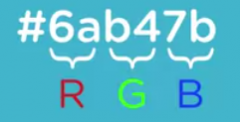![]()
![]()
![]()
Use LEFT and RIGHT arrow keys to navigate between flashcards;
Use UP and DOWN arrow keys to flip the card;
H to show hint;
A reads text to speech;
35 Cards in this Set
- Front
- Back
|
HTML |
Hyper Text Markup Language, the computer code that defines the structure of web pages. |
|
|
CSS |
Cascading Style Sheets, the computer code that defines the visual presentation of web pages. |
|
|
The Web |
The network of linked HTML documents that exists on the Internet. |
|
|
Internet |
The global system of computer networks and hardware on which the web is built. |
|
|
Wireframes |
Drawing technique used to create the shapes and visual structure of a website. |
|
|
HTML5 |
New HTML elements that are now commonplace along with a few new pieces of browser technology. |
|
|
Attributes |
Extra information inside of an HTML element that provides additional data about the element. |
|
|
Code Completion |
A feature of text editors (like Workspaces) that automatically completes code as you type. |
|
|
HTML Entity |
Special characters in HTML, such as the copyright symbol. |
|
|
Relative Path |
Describes the location of a file using a partial file path that's based on the location of the original file relative to the file that's being referenced. |
|
|
Absolute Path |
Describes the location of a file using the full file path. |
|
|
Rule |
The entirety of a CSS selector and its declarations. |
|
|
Selector |
CSS syntax that defines elements on a page to which declarations should be applied. |
|
|
Declaration |
Pairs of CSS properties and values that define how an element should be styled. |
|
|
Property |
CSS syntax that defines which part of an element should be styled, such as its color, size, position, and so on. |
|
|
Value |
CSS syntax that sets the variable units for properties. |
|
|
Type Selector |
Also known as an "element selector" this CSS selector that isolates all the elements of a given type. |
|
|
Descendent Selector |
CSS selector that selects all the elements of a given type that are nested inside another type of element. |
|
|
ID Selector |
CSS selector that selects a single element based on its ID attribute. |
|
|
Mobile First |
The technique of creating mobile websites first and then progressively enhancing them to create the desktop version. |
|
|
Hexadecimal |

A base-16 number system that uses the letters "A" through "F" to represent the numerals 10 through 15. #000000 = Black #ffffff = White #888888= Gray |
|
|
Pseudo-Class |
Dynamic selectors that change based on user interaction with the browser, such as hovering over a link, for example. |
|
|
Class Selectors |
Selects any HTML element that contains a matching class attribute. |
|
|
Comment |
A reminder or visual cue in computer code that's meant to be readable by programmers. Comments are typically not interpreted by the browser and shouldn't impact a website's function in any way. |
|
|
Block-level Elements |
Block elements occupy the width of their containers and generally include a line break before and after the element. |
|
|
Inline Elements |
Inline elements occupy the width of their contents and do not begin a new line when formatted as text. |
|
|
index.html |
A special HTML filename that almost every web server recognizes as the "home page" of a website. |
|
|
Protocol |
A system of rules for the exchange of digital information. On the web, the Hyper Text Transfer Protocol (HTTP) allows for the exchange of websites. |
|
|
Subdomain |
A smaller domain that is part of a larger domain. For example, "www" is a common subdomain. |
|
|
Domain |
A unique identifying string that defines a realm of authority or control on the web. |
|
|
TLD |
TLD stands for Top Level Domain and it is the highest level domain in the Domain Name System (DNS). This is the part of the domain such as .com, .net, and .org, that comes at the end. |
|
|
IP Address |
Internet Protocol (IP) address is a set of numbers assigned to a location on a network. In general, a domain name represents an IP address, so that users don't need to remember these long strings of numbers. |
|
|
DNS |
The Domain Name System (DNS) is a global routing system for IP addresses on the Internet. |
|
|
Responsive Web Design |
A technique for creating websites that work on multiple screen resolutions via the combination of fluid images, fluid grids, and media queries. |
|
|
Breakpoints |
The specific screen widths where a responsive layout "breaks" and needs to change in order to accommodate the screen. |

